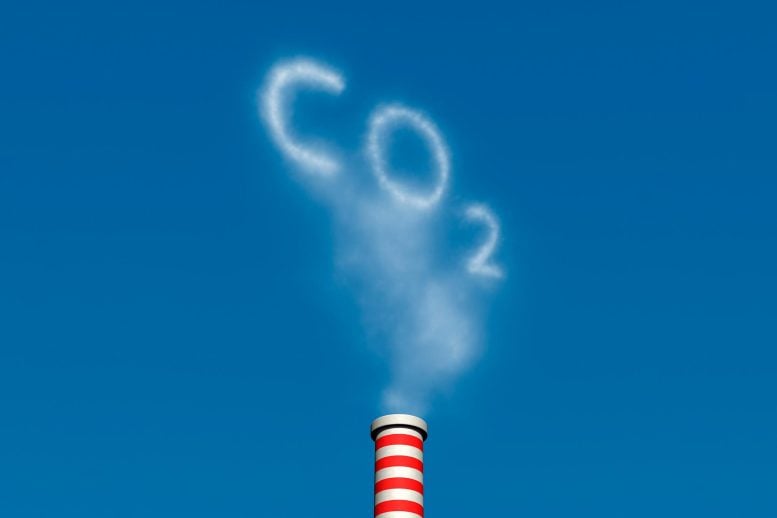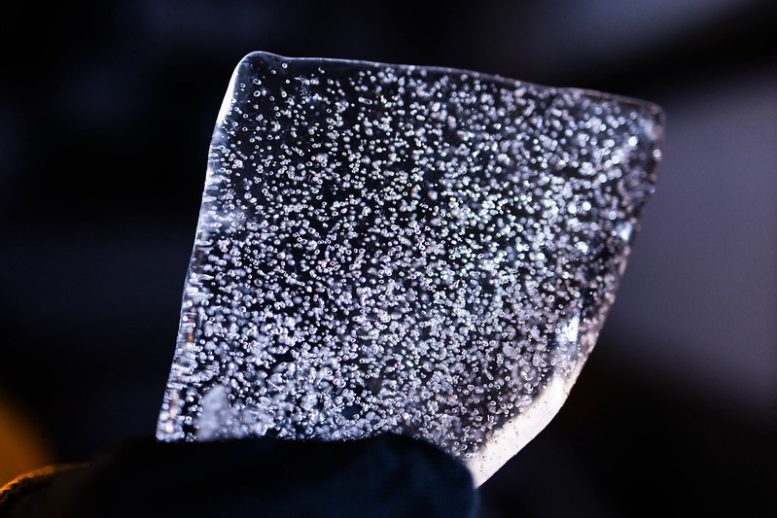
Recent research indicates that the current rate of atmospheric CO2 increase is unprecedented, being ten times faster than any period in the last 50,000 years, highlighting significant implications for global climate dynamics and future CO2 absorption capabilities of the Southern Ocean.
Researchers conducting a detailed chemical analysis of ancient Antarctic ice have discovered that the current rate of increase in atmospheric carbon dioxide is 10 times faster than at any point in the last 50,000 years.
The findings, just published in the Proceedings of the National Academy of Sciences, provide an important new understanding of abrupt climate change periods in Earth’s past and offer new insight into the potential impacts of climate change today.
“Studying the past teaches us how today is different. The rate of CO2 change today really is unprecedented,” said Kathleen Wendt, an assistant professor in Oregon State University’s College of Earth, Ocean, and Atmospheric Sciences and the study’s lead author.
“Our research identified the fastest rates of past natural CO2 rise ever observed, and the rate occurring today, largely driven by human emissions, is 10 times higher.”
Carbon dioxide, or CO2, is a greenhouse gas that occurs naturally in the atmosphere. When carbon dioxide enters the atmosphere, it contributes to the warming of the climate due to the greenhouse effect. In the past, the levels have fluctuated due to ice age cycles and other natural causes, but today they are rising because of human emissions.
Ice Core Analysis in Antarctica
Ice that built up in the Antarctic over hundreds of thousands of years includes ancient atmospheric gasses trapped in air bubbles. Scientists use samples of that ice, collected by drilling cores up to 2 miles (3.2 kilometers) deep, to analyze the trace chemicals and build records of past climate. The U.S. National Science Foundation supported the ice core drilling and the chemical analysis used in the study.
Previous research showed that during the last ice age, which ended about 10,000 years ago, there were several periods where carbon dioxide levels appeared to jump much higher than the average. But those measurements were not detailed enough to reveal the full nature of the rapid changes, limiting scientists’ ability to understand what was occurring, Wendt said.

A slice from an Antarctic ice core. Researchers study the chemicals trapped in old ice to learn about past climate. Credit: Katherine Stelling, Oregon State University
“You probably wouldn’t expect to see that in the dead of the last ice age,” she said. “But our interest was piqued, and we wanted to go back to those periods and conduct measurements at greater detail to find out what was happening.”
Using samples from the West Antarctic Ice Sheet Divide ice core, Wendt and colleagues investigated what was occurring during those periods. They identified a pattern that showed that these jumps in carbon dioxide occurred alongside North Atlantic cold intervals known as Heinrich Events that are associated with abrupt climate shifts around the world.
“These Heinrich Events are truly remarkable,” said Christo Buizert, an associate professor in the College of Earth, Ocean, and Atmospheric Sciences and co-author of the study. “We think they are caused by a dramatic collapse of the North American ice sheet. This sets into motion a chain reaction that involves changes to the tropical monsoons, the Southern hemisphere westerly winds, and these large burps of CO2 coming out of the oceans.”
Comparison of Natural and Current CO2 Increases
During the largest of the natural rises, carbon dioxide increased by about 14 parts per million in 55 years. And the jumps occurred about once every 7,000 years or so. At today’s rates, that magnitude of increase takes only 5 to 6 years.
Evidence suggests that during past periods of natural carbon dioxide rise, the westerly winds that play an important role in the circulation of the deep ocean were also strengthening, leading to a rapid release of CO2 from the Southern Ocean.
Other research has suggested that these westerlies will strengthen over the next century due to climate change. The new findings suggest that if that occurs, it will reduce the Southern Ocean’s capacity to absorb human-generated carbon dioxide, the researchers noted.
“We rely on the Southern Ocean to take up part of the carbon dioxide we emit, but rapidly increasing southerly winds weaken its ability to do so,” Wendt said.
Reference: “Southern Ocean drives multidecadal atmospheric CO2 rise during Heinrich Stadials” by Kathleen A. Wendt, Christoph Nehrbass-Ahles, Kyle Niezgoda, David Noone, Michael Kalk, Laurie Menviel, Julia Gottschalk, James W. B. Rae, Jochen Schmitt, Hubertus Fischer, Thomas F. Stocker, Juan Muglia, David Ferreira, Shaun A. Marcott, Edward Brook and Christo Buizert, 13 May 2024, Proceedings of the National Academy of Sciences.
DOI: 10.1073/pnas.2319652121
Additional co-authors include Ed Brook, Kyle Niezgoda, and Michael Kalk of Oregon State; Christoph Nehrbass-Ahles of the University of Bern in Switzerland and the National Physical Laboratory in the United Kingdom; Thomas Stocker, Jochen Schmitt and Hubertus Fischer of the University of Bern; Laurie Menviel of the University of New South Wales in Australia; James Rae of the University of St. Andrews in the United Kingdom; Juan Muglia of Argentina; David Ferreira of the University of Reading in the United Kingdom and Shaun Marcott of University of Wisconsin-Madison.
The study was funded by the U.S. National Science Foundation.









Of course it is. There are eight billion people in need of energy. You don’t need to look at the distant past to know that. The more important question is…how do we make a transition away from fossil fuels without adding more CO2 in the process?
Wide spread genocide would work.
So many scary and weird things are happening every day with the world l really feel bad for the animals and sea manimals they are going to be extinct and this fighting wars are bombing and testing out the nuclear missiles other countries don’t listen this is f***ed up we are going to be we’re going to be baked it’s like being in the oven 🔥 we have to do something fast
Lets plant some trees.
!
Tree planting is a complex subject, that has been oversimplified. Done wrong it can be counter productive. Scientists say protecting existing mature forest does the job better. Replanting lost forests is a lot better than planting new ones. Not on grassland and not too much on desert either. Those both have higher albedo (reflects sunlight back into space). Native grasses, like used to cover the U.S. Great Plains, have much deeper roots than human planted grasses. So they hold both moisture and carbon in the soil better.
I have an image on my laptop showing human planted Kentucky Bluegrass and Smooth Brome grasses with roots about 6 and 10 inches deep respectively; compared with the native grasses Sideoats Grama and Big Bluestem that have roots 5 and 9 Feet deep respectively.
You fail to say how fast it is rising.
In last two years, CO2 has gone up 3ppm each year.
Just a few years ago, the rate was 2.5ppm/yr.
In 2000, it was 1 ppm/yr.
You see the rate is increasing.
Now, we will be at 500ppm by 2050, and 650ppm by 2100.
And, that is assuming no further increase in the rate, which seems a stretch.
The Earth has not seen levels of 500ppm since the PETM, and the Cretaceous.
During those times, ice did not exist at the poles.
If we replicate those conditions, oceans will be 200ft deeper than today.
The real question now, is how long will that process take?
Decades? Centuries? or Millenia?
Interestingly, the seasonal CO2 ramp-up phase — Fall through Spring — shows a greater increase in El Nino years than in typical years, suggesting that warmth is driving greater production of biogenic CO2, which is the opposite of the consensus hypothesis. Additionally, during the 2020 shutdowns, anthropogenic CO2 emissions, about 4% of the total annual flux, declined by as much as 14-18% in April, with an average decline of about 10%. Yet, the slope and peak of the seasonal 2020 net-CO2 is no different in appearance than 2019 or 2021, suggesting that the sinks are muting the anthropogenic emissions. If the right questions aren’t asked, there is little hope of getting the right answers.
https://wattsupwiththat.com/2022/03/22/anthropogenic-co2-and-the-expected-results-from-eliminating-it/
https://wattsupwiththat.com/2021/06/11/contribution-of-anthropogenic-co2-emissions-to-changes-in-atmospheric-concentrations/
Anagnostou, et al. (2016) state, “However, existing estimates place atmospheric carbon dioxide (CO2) levels during the Eocene at 500–3,000 parts per million and in the absence of tighter constraints carbon–climate interactions over this interval remain uncertain.”
It is more likely that the PETM was at 3,000 PPMV than 500.
FALSE conclusion from a NON credible source.
El Nino adds to global temperature and may have an effect on natural CO2 increase, but that amount is TINY compared with how much we have added to the atmosphere. You repeated TWO LIES about the science based on a Falsehood or three.
“anthropogenic CO2 emissions, about 4% of the total annual flux, declined by as much as 14-18% in April, with an average decline of about 10%”
ONE more denier misrepresentation of the science. It ignore the Other Half of the carbon cycle, the Flux OUT of the atmosphere. The natural sources of flux INTO the atmosphere are Taking more Out than they Put In. We are only involved with the flux into the atmosphere – a one way street.
In the natural fast or active carbon cycle all the components give and take carbon, thus it stays pretty balanced.
Fossil fuels emissions do not even belong in the fast carbon cycle, only in the very long time scale slow cycle.
So ALL the CO2 from fossil fuels is IN ADDITION to the amount that normally moves through the carbon cycle.
And a one way street.
It’s carbon that has been locked out of the fast carbon cycle for a long time. Most of the coal formed about 300 million years ago, and the oil 100 million years ago.
We are now putting it all into the fast carbon cycle in a nanosecond of geological time.
And thus causing global warming.
“suggesting that warmth is driving greater production of biogenic CO2, which is the opposite of the consensus hypothesis.”
Oh, now I see what you did. Didn’t catch that part.
The good ole denier slogan “CO2 follows temperature”.
The greenhouse gas effect of CO2 has been known for 168 years, and it’s far better understood now.
CO2 doesn’t care how it gets in the atmosphere, it will Always have its greenhouse effect.
Climate scientists all agree that the initial warming that triggers the end of an ice age is Milakovitch cycles, or Orbital Forcing. But they also know that this hasn’t enough radiative forcing to melt the ice sheets that are a couple of miles thick and bring on an interglacial period.
What does most of the warming is feedbacks that kick in, Especially CO2.
peer reviewed sources:
Martin et al. 2005;
Toggweiler et al. 2006;
Schmittner and Galbraith 2008;
Skinner et al. 2010;
Shakun et al 2012
According to the peer reviewed research by Shakun et al., 93% of the global warming happened AFTER the CO2 increase, when the last glacial period ended.
—————————
Regarding what I previously said about fossi fuels and the carbon cycle:
The Carbon Cycle
“Without human interference, the carbon in fossil fuels would leak slowly into the atmosphere through volcanic activity over millions of years in the slow carbon cycle. By burning coal, oil, and natural gas, we accelerate the process, releasing vast amounts of carbon (carbon that took millions of years to accumulate) into the atmosphere every year. By doing so, we move the carbon from the slow cycle to the fast cycle. In 2009, humans released about 8.4 billion tons of carbon into the atmosphere by burning fossil fuel.”
(now more like 10 billion tons per year)
https://earthobservatory.nasa.gov/features/CarbonCycle
“The greenhouse gas effect of CO2 has been known for 168 years, and it’s far better understood now.”
The problem is that what happens isn’t just a simple absorption of IR by CO2/CH4, but is instead, a complex dynamic of feedback loops such as albedo change, principally cloudiness.
There is no agreement on what the climate sensitivity is for a doubling of CO2, and the range of estimates has increased over time. Modeling is an attempt to understand how it all interrelates. However, ALL but the Russian model seriously overestimate the warming, and of the rest there is a wide range in the forecast for any given scenario. The ensemble average only compensates if there is a Gaussian distribution of errors around the correct values. The Russian model strongly suggests that there is a significant systematic bias in the other models, negating the assumption of a distribution around the true values. Logically, there can only be one best model. If one averages all the less skilled models with the best one, the result will be less skillful than the best one.
“CO2 doesn’t care how it gets in the atmosphere, it will Always have its greenhouse effect.”
The Corollary to that is that sinks don’t discriminate anthropogenic CO2 from natural CO2; the sinks actually withdraw the CO2 from different sources in proportion to their relative abundance.
“FALSE conclusion from a NON credible source.”
Are you claiming that Anagnostou, et al. (2016) is non-credible? If so, why? It is a relatively recent peer-reviewed article in Nature. Are we supposed to believe your claim based on nothing but your opinion?
“El Nino adds to global temperature and may have an effect on natural CO2 increase, but that amount is TINY compared with how much we have added to the atmosphere.”
Your unexamined assumption is that virtually ALL of the increase in CO2 is anthropogenic. Speaking of denying, you are basically denying that 1) the warming oceans are out-gassing increased CO2 as millennia-old bottom water up-wells in the tropics and along the west coast of the continents, 2) that as the Earth greens (as documented by NASA) there isn’t increased respiration from the new vegetation, 3) that as the Winters become warmer there isn’t increased respiration from the roots of Boreal trees, and 4) as the tundra warms there isn’t increased microbial decomposition of the sequestered organic material.
“ONE more denier misrepresentation of the science. It ignore the Other Half of the carbon cycle, the Flux OUT of the atmosphere.”
No, my calculation of about 4% implicitly includes in-flux and out-flux because they are approximately balanced and the fossil fuel percentage is small compared to the natural components. The seasonal variation (~6-8 PPMV) is driven by temperature and biological activity .
It takes quite an imagination to think that it isn’t humans increasing CO2, or that it isn’t the cause of the warming, after an accumulated Himalayan Mountain Range of evidence for AGW, a huge amount empirical evidence.
Here’s what we have done, compared with nature.
Humans increased CO2 by 25ppm in the last 10 years
Humans increased CO2 by 45ppm in the last 20 years.
Humans increased CO2 by over 80ppm in the last 60 years
Humans increased CO2 by 100ppm in the last 70 years
Humans increased CO2 by 144ppm in the last 143 years
———
Nature caused CO2 increases over the last 450,000 years, from ice core data
80ppm increase — took 50,000 years
110ppm increase — 25,000 years
120ppm increase — 20,000 years
60ppm increase — 20,000 years
90ppm increase — 15,000 years
100ppm increase — 24,800 years
And a graph of 800,000 years, from ice core data shows about the same.
CO2 was never over 300pp and only was that high once, about 300,000 years ago.
The range was 170-300ppm.
“It takes quite an imagination to think that it isn’t humans increasing CO2, …”
No, just a willingness to consider multiple working hypotheses and not prematurely lock oneself into a particular hypothesis before all the questions are answered.
“Here’s what we have done, compared with nature. Humans increased CO2 by 25ppm in the last 10 years”
Clearly, CO2 has increased. However, the unstated assumption is that it is all from humans. The problem is, there is no correlation with de-trended data, begging the question of whether it is a spurious correlation, or if the cause and effect are inverted.
“And a graph of 800,000 years, from ice core data shows about the same.”
Speaking of which, the Law Dome C data strongly suggests an increase in temperature well before a change in CO2.
You said, “The Earth has not seen levels of 500ppm since the PETM, and the Cretaceous.”
According to Wikipedia, “During the Cretaceous Thermal Maximum (CTM), atmospheric carbon dioxide levels rose to over 1,000 parts per million (ppm) …” You are only off on your numbers by 100%. I suppose that is good enough for government work.
Looks to me like you’re twisting his words.
Was CO2 1000ppm for the entire Cretaceous?
What he meant was at least 500ppm, and those were the last two times that fit.
“Was CO2 1000ppm for the entire Cretaceous?”
Neither the Cretaceous or Eocene were the same temperature for their duration.
He is implying that the Earth will experience a climate similar to the PETM and Cretaceous when they had CO2 concentrations of about 500 PPM. I am pointing out that the concentration for the extreme climates were more likely on the high end of the estimate.
Sure it is
All the university graduates who are blaming motorists and people either trying to keep warm or cool for the rise in co2 . BUILDING IN OUR CITIES IS THE MAJOR CAUSE OF THE CO2
BUT YOUR UNIVERSITY EGG HEADS IGNORE THE OBVIOUS AND INSTEAD CONCENTRATE ON THE WELFARE OF SPIDERS AND MAGGOTS INSTEAD AND THIS SCIENTIFIC JOURNAL IS OBEDIENTLY CARRYING ALL THIS PROPAGANDA
I wonder how many of these commenters stopped living in wooden homes, stopped driving their car. I’m sure all these warriors gave up the internet and modern society as a whole. As evidenced by their continued comments. I bet every single one of these “people” ride their bikes to work, to school, to the store, to their kids school, etc. I bet they even gave up that trip to Europe for the sake of the environment…
Oh what’s that? Theyve done absolutely none of this and only expect you and younger generations to? Wild… just wild.
40% of world annual CO² emissions are coming from China… Until they stop using the world for their toilet forget doing anything.
Boycott all things China
It is known that atmospheric pressure and distance from the sun have a major impact on the temperature of any planet or moon. It is interesting that, when you normalize for these two variables on literally any planet that we can observe, the temperature is the same everywhere within a couple degrees C. For example, Venus has far greater atmospheric pressure than Earth. But when you go high enough into the atmosphere of Venus that air pressure is equal to earth, the temperature on Venus (normalized for the fact it’s closer to the sun) is exactly equal to earth, within 1 degree C. This is despite the fact that earth has 418 parts per million CO2, while Venus has 750,000 parts per million CO2 in its air. It’s puzzling that thousands of times more CO2 in the air seems to have zero impact on temperature anywhere in the solar system. One theory is that there is a point where CO2 is dense enough in the atmosphere that it basically captures all the heat it can from the limited light spectrum that it impacts (perhaps at 500 ppm on earth) and beyond that, additional CO2 has no impact. This would explain why earth used to have 10x more CO2 than today, with temperatures equal to today, while we are seeing temperature rise a small amount currently, as CO2 rises.